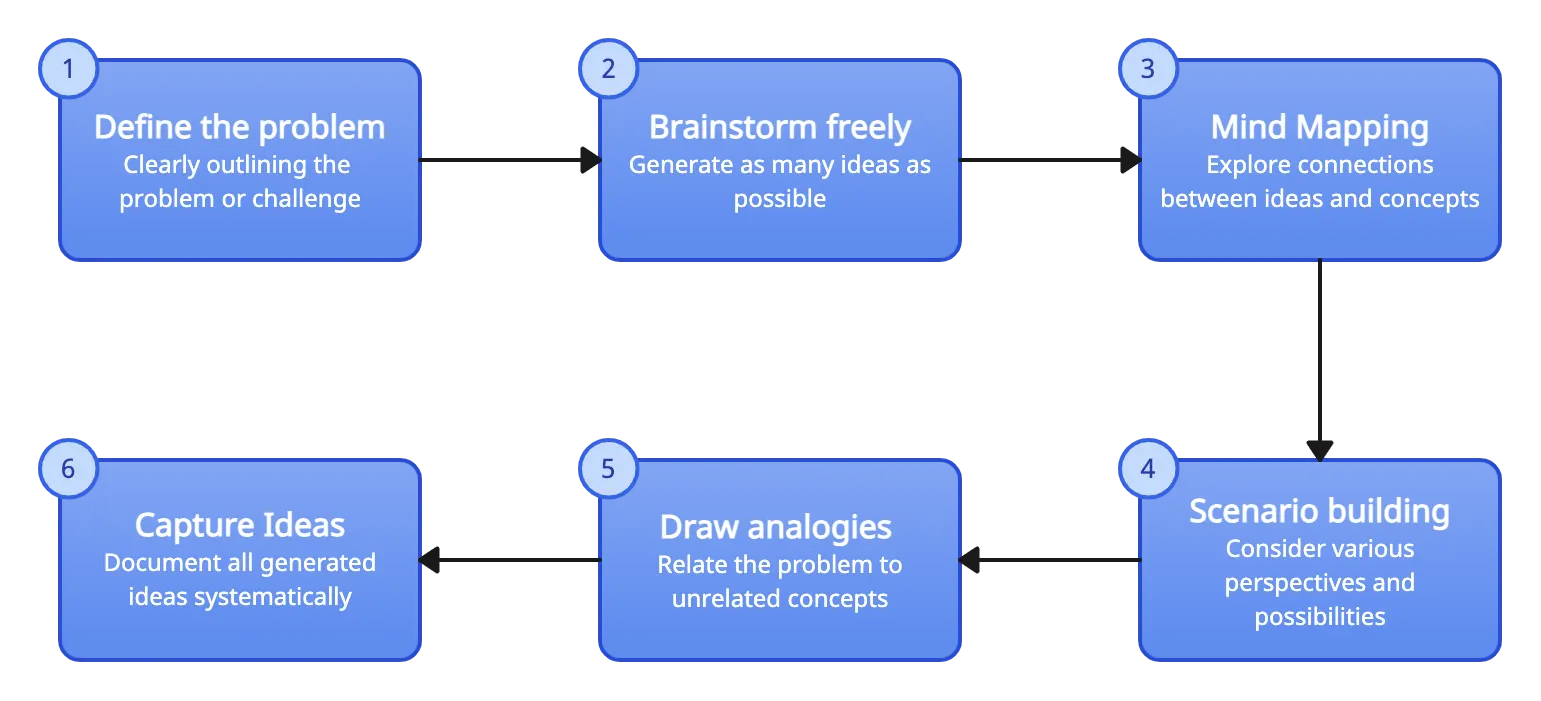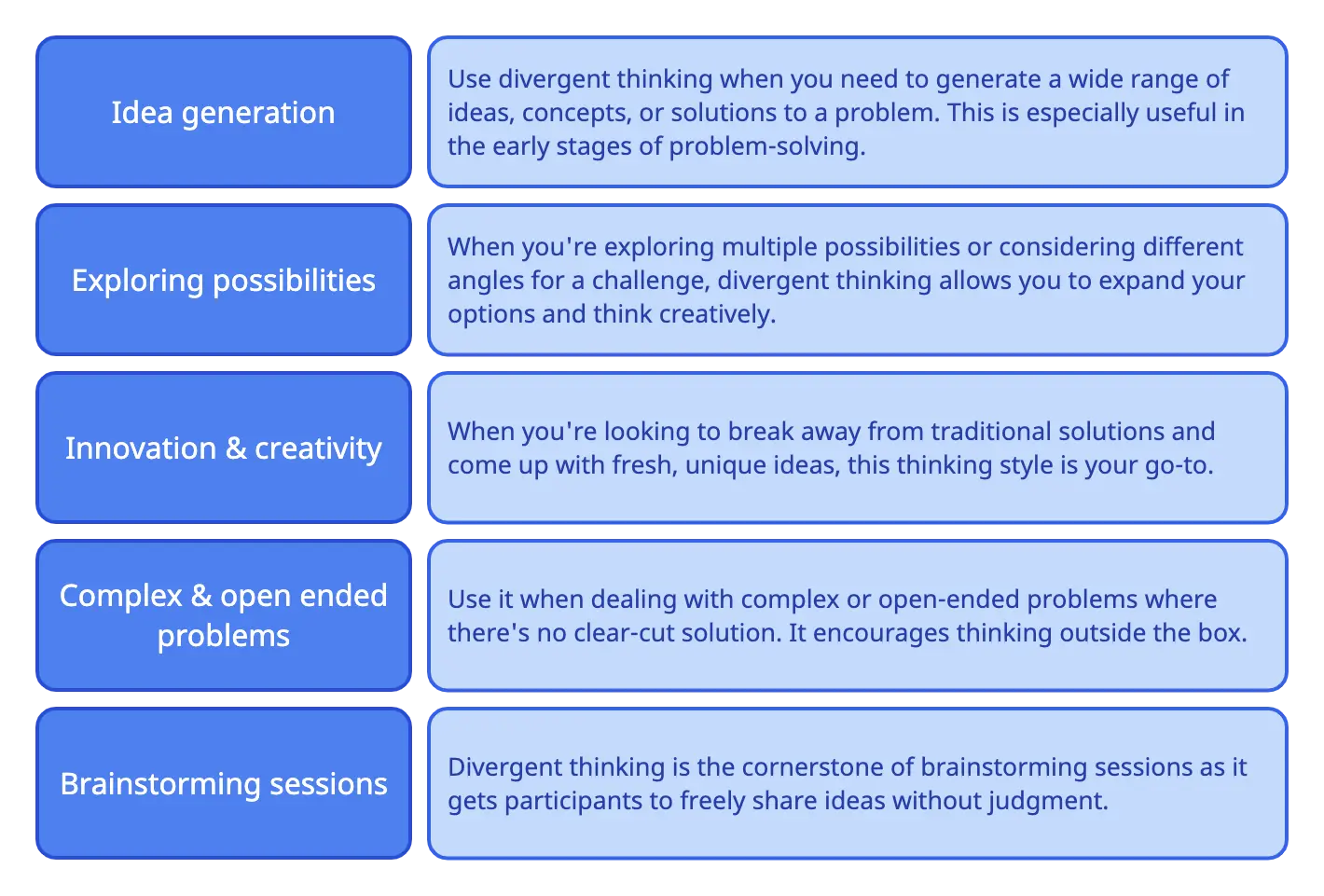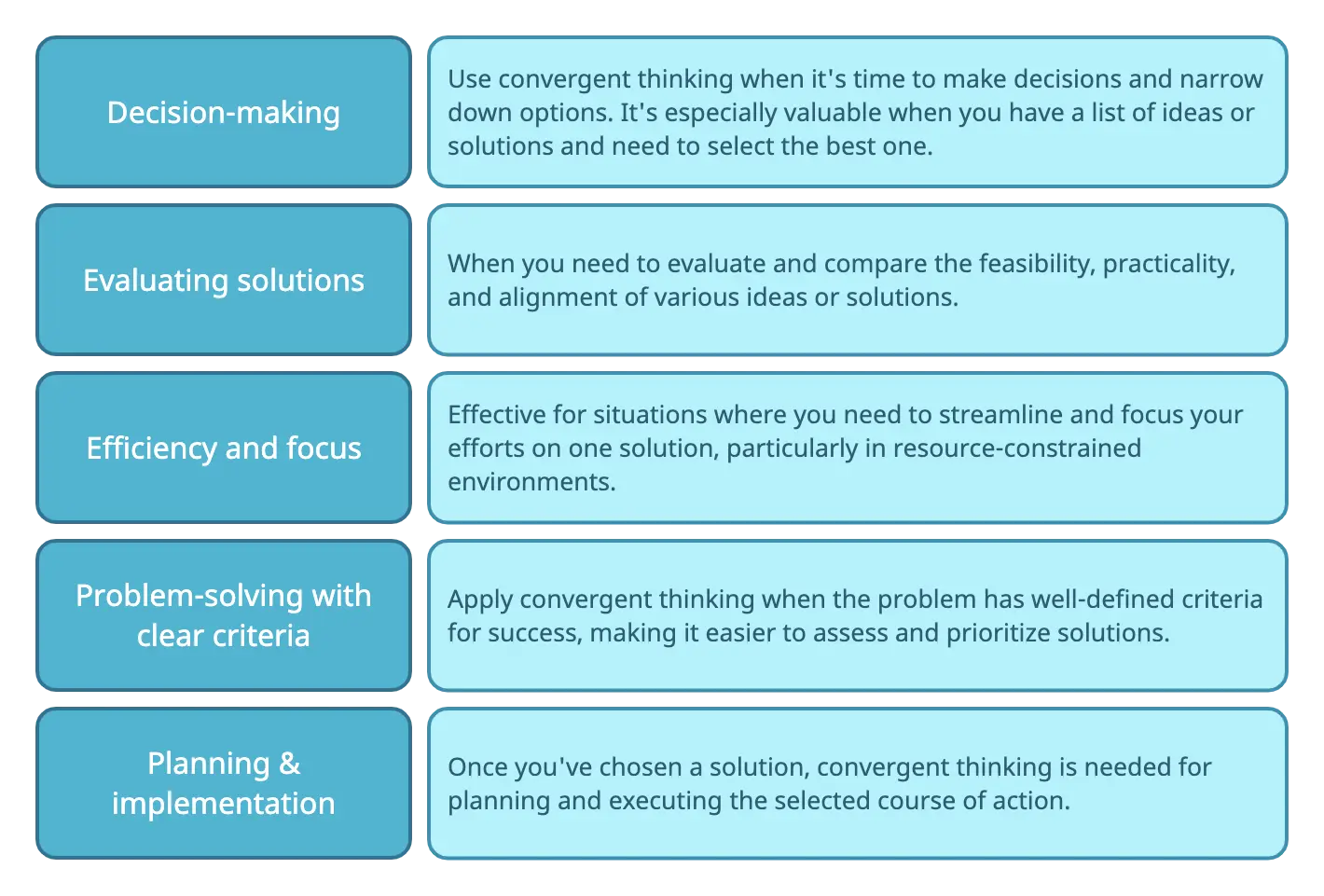Divergent and convergent thinking are key components of problem-solving and decision-making, often used across different fields. They represent two different ways of approaching challenges: one focuses on generating many ideas, while the other narrows them down to find the best solution.
In this article, we’ll break down divergent vs convergent thinking styles, explore their practical applications, and show how they can help make better decisions and solve complex problems effectively.
Divergence vs Convergence: Definition
Divergence and convergence are two opposing cognitive processes that play distinct roles in problem-solving and decision-making.
Divergence
Divergent thinking is a creative process that helps generate a wide range of ideas or possibilities. It involves thinking broadly, exploring different angles, and coming up with multiple solutions to a problem. The main goal of divergent thinking is to promote creativity by allowing a free flow of thoughts without judgment or evaluation.
Convergence
Convergent thinking, on the other hand, is a focused and analytical process aimed at selecting the best solution or idea from a set of options. It involves carefully evaluating, comparing, and narrowing down choices to identify the most effective and practical solution to a problem. Convergent thinking is about making decisions and finding the most suitable answer based on specific criteria, often guided by logic, data, and established principles.
This comparison chart gives a quick overview of the differences between divergent and convergent thinking.
| Aspect | Divergent Thinking | Convergent Thinking |
|---|---|---|
| Goal | Generate many ideas or possibilities. | Select the best idea or solution. |
| Approach | Free-flowing and creative brainstorming. | Analytical and decision-making. |
| Emphasis | Exploration of new and different possibilities. | Evaluation and logical selection. |
| Process | Quantity-focused, exploring various perspectives. | Quality-focused, seeking the optimal choice. |
| Function | Idea generation and creativity. | Decision-making and solution selection. |
| Flexibility | Open-ended and exploratory. | Structured and analytical. |
| Outcome | Numerous ideas without immediate judgment. | A specific, chosen solution. |
How to Apply Convergent and Divergent Thinking
Convergent and divergent Thinking aren’t separate stages, but often work together iteratively. You may need to switch between these thinking styles multiple times to fine-tune and improve your ideas. Additionally, involving a mix of people with different skills and thinking styles and expertise can also help increase the quality of both your divergent and convergent thinking processes.
Applying Divergent Thinking

Define the problem: Start by clearly outlining the problem or challenge you’re facing. Understand its scope and boundaries.
Brainstorm freely: Hold a brainstorming session where you and your team generate as many ideas as possible. During this phase:
- Do not criticize or judge ideas.
- Welcome unconventional and even seemingly impractical ideas.
- Build upon the ideas of others to spark creativity.
Mind mapping: Use mind maps or visual diagrams to explore connections between ideas and concepts. This can help you see the bigger picture and identify potential solutions.
- Role play and scenario building: Imagine yourself in different scenarios related to the problem. Role-playing and scenario building can help you consider various perspectives and possibilities.
Analogies and metaphors: Draw analogies or use metaphors to relate the problem to unrelated concepts. This can help generate fresh insights and creative solutions.
Idea capture: Document all generated ideas systematically, either on paper or digitally. Organize them for easy reference during the convergent thinking phase. Use the following brainstorming board to quickly record and organize ideas.
Applying Convergent Thinking

Evaluate ideas: Review the list of generated ideas from the divergent thinking phase. Consider factors like feasibility, practicality, and alignment with your goals and constraints.
Set criteria: Define specific criteria or parameters for evaluating ideas. This could include cost-effectiveness, time constraints, and the potential for implementation.
Rank and prioritize: Rank the ideas based on their alignment with the established criteria. Prioritize the top ideas that best meet your objectives.
Select the best option: Choose the single best solution or idea from the prioritized list. This decision should be well-reasoned and backed by data and analysis.
Plan implementation: Develop a detailed action plan for implementing the chosen solution. Outline the steps, resources, and timeline required for execution.
Test and iterate: Implement the chosen solution and monitor its progress. If necessary, be open to making adjustments and iterations based on feedback and results.
Reflect and learn: After implementing the solution, reflect on the process. What worked well? What could be improved? Use these insights for future problem-solving.
The Pros and Cons of Divergent Thinking vs Convergent Thinking
Convergent Thinking Pros and Cons
| Pros | Cons |
|---|---|
| Quick and decisive choices | May lead to settling for a solution prematurely |
| Logical and systematic evaluation | Tends to favor practical over innovative solutions |
| Effective for well-defined issues | May not explore all possible viewpoints |
| Concentrated effort on one solution |
Divergent Thinking Pros and Cons
| Pros | Cons |
|---|---|
| Fosters creativity and innovation | Can be time-consuming |
| Encourages an open-minded approach | Excessive information can be overwhelming |
| Considers multiple angles | May lack clear focus and direction |
| Promotes experimentation | May not work well for structured issues |
When to Use Divergent and Convergent Thinking
Knowing when to use divergent thinking vs convergent thinking is key to effective problem-solving and decision-making.
Divergent Thinking

Convergent Thinking

Convergent vs Divergent Thinking in Project Management
In real projects, you often switch between these two thinking styles. Divergent thinking starts things off with idea generation and exploration during planning. As the project moves forward, convergent thinking takes over to make precise decisions and execute efficiently.
Project managers use convergent thinking to analyze data, evaluate options, and select the most suitable solutions for the project. It’s particularly helpful when you have clearly defined problems or need to allocate resources efficiently. Convergent thinking makes sure that your project stays on course and meets its objectives with precision.
Divergent thinking, on the other hand, is the thinking style you turn to when you’re dealing with complex, open-ended challenges or seeking fresh, imaginative ideas. Project managers use divergent thinking for brainstorming and idea generation without constraints. This approach is useful in exploring various possibilities, finding unique solutions, and injecting creativity into the project.
FAQs About Divergent Thinking and Convergent Thinking
Can divergent and convergent thinking be used together?
What are some examples of divergent thinking activities?
What tools help with convergent thinking?
How do divergent and convergent thinking benefit teams?
What are the Tips to Get the Most out of Divergent & Convergent Thinking
- Clear problem definition
- Time management
- Diverse teams
- Document everything
- Flexibility
- Visual collaboration
- Iterative approach






